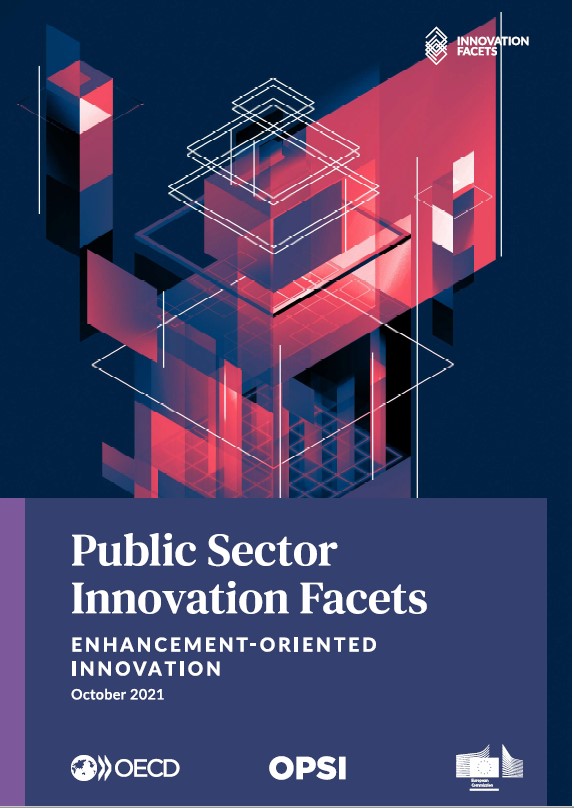Public Sector Innovation Facets: Enhancement-Oriented Innovation

What is enhancement-oriented innovation?
Enhancement-oriented innovation upgrades practices, achieves efficiencies and better results, without significantly altering the current system. It starts with the question: “How might we do X better?” It is driven by public sector constraints on resources and costs, the influential principles of New Public Management – a market-driven public administration paradigm – and by the digitalisation and adoption of new technologies. Tools and methodologies to stimulate and manage enhancement-oriented innovation include lean and six sigma methodologies, project management and quality improvement methods, open innovation and behavioural insights approaches.
The challenge
Rapid technological change, austerity policies and rising expectations of government services have put the public sector under increasing pressure to serve citizens better, faster and more efficiently, all while minimising costs. Governments are expected to extend choice in services, tailor and personalise these to particular user needs, and be evidence-informed in service allocation and decision making. Public sector organisations must enhance their current operating systems continuously, while at the same time demonstrating greater efficiency, user-centricity and value for money
Main drivers and enabling conditions of enhancement-oriented innovation
Enhancement-oriented innovation in the public sector is driven by three main factors. First, reductions in resources can incentivise an organisation to operate differently and “do more with less”. Second, the New Public Management (NPM) paradigm, which has influenced many public sector institutions since the 1980s, can motivate organisations to seek greater efficiency through innovation, often delegating this function to private actors. And third, digitalisation and the adoption of new technologies has led to, among other impacts, increased effectiveness in new service delivery channels and improved productivity.
These three drivers, either individually or in unison, lead to different types of innovation. For example, when resulting from budget cuts and NPM pressures, enhancement-oriented innovation is often reactive and fragmented, and can lack directionality. Digitalisation, on the other hand, pushes public organisations to innovate with strategic intent, enabling enhancement-oriented innovation to become part of a longer-term, structured change process.

Digitising tax services in Austria
The Austrian tax administration has digitised its services and integrated a chatbot function for users. The services can be accessed through the FinanzOnline platform. FinanzOnline is the most used e-government portal in Austria and represents 20 years of incremental improvements. The customer service strategy of the tax administration is to offer a single front-end system for all target audiences. The administration’s approach focuses on the user rather than designing the digital platform around legal requirements. The team has also created applications for smartphones and has reconfigured the platform to support video chats, integrating FinanzOnline into the broader IT landscape of the Austrian government.
???????? Austria
Tools and methods
The brief discusses a non-exhaustive list of tools and methods used by public sector organisations to stimulate and manage enhancement-oriented innovation. The most frequently applied approaches are connected to lean and Six Sigma methodologies, project management and quality improvement methods, open innovation and behavioural insight approaches.
Lean and Six Sigma methodologies
Lean methodologies are an important tool for stimulating enhancement-oriented innovation in public sector organisations. Originating from the car manufacturing sector in the 1980s, this approach optimises costs and reduces waste via a constant focus on customer needs and value. Sigma approaches usually use a five-part structured methodology termed DMAIC (Define-Measure-Analyse-Improve-Control), through which organisations can more effectively identify issues and implement solutions. Lean approaches can also be a response to budget pressures in local administrations, leading to the creation of one-stop-shops and other service innovations that improve the identification of citizen needs.
Project management and quality improvement methods
Quality improvement and management methods are another key tool related to enhancement-oriented innovation. An example is the Common Assessment Framework (CAF), a tool developed to help European public organisations improve their performance by using innovation and knowledge management, among other things, to enhance their effectiveness and customer orientation. Other tools include the PRINCE2 project management approach and blueprinting. PRINCE2 focuses on the division of processes into packages and streams, the interdependencies between them, and their completion on time and within budget. Blueprinting, on the other hand, involves a graphical representation of an organisation’s service delivery process which creates a clearer understanding of the needs of both the service users and the staff behind it.
Open innovation
Open innovation means opening up public organisations’ innovation processes to citizens and external stakeholders. This makes use of knowledge that lies outside organisational boundaries to improve processes and services, increase legitimacy and strengthen citizen participation in the public sphere.
Behavioural Insights approaches
Innovative behavioural insights (BI) tools can strengthen the effectiveness of public services and processes. Behavioural nudges, for example, are a useful technique to incentivise citizens to change their behaviour in line with desired policy outcomes in more effective and cost-efficient ways compared to traditional economic incentive tools.

Reducing antimicrobial resistance through behavioural sciences in Australia
A behavioural insights approach was used in the Australian health sector in a trial involving General Practitioners (GPs). The aim was to diminish the number of antibiotic prescriptions and reduce the overall risk of antimicrobial resistance and medicine ineffectiveness. The intervention consisted of letters sent to GPs with information on the dangers of antimicrobial resistance. It led to an estimated overall reduction of 126 352 prescriptions after six months, equal to a 9.3% to 12.3% reduction based on different letter types.
???????? Australia
Skills and capacities needed for enhancement-oriented innovation
The absence of market feedback mechanisms in most public sector organisations causes a greater reliance on internal capabilities to create value and remain relevant. This relative lack of external pressure to innovate heightens the importance of active capacity and skills building for enhancement-oriented innovation at the employee and the leadership level.
At the employee level, public servants require good digital skills and learning capacities to be able to initiate and implement enhancement-oriented innovations. At the leadership level, public sector managers need to create conditions to stimulate the creativity of employees for change and innovation. By putting in place effective employee empowerment practices that provide employees with better task knowledge, managers can foster innovative ideas about how to improve internal processes at lower hierarchical levels.
Policy relevance
The compatibility of enhancement-oriented innovation with existing paradigms and with the overall status quo of the organisation makes it one of the less contested and more easily promoted innovation types in the innovation facets model. Nonetheless, four challenges are associated with its adoption and implementation.
- Over-specialisation: organisations that are overly concerned with process optimisation can suffer from an excessive focus on inward looking, results-based approaches and risk avoidance, which makes them unable to confront changing scenarios and future challenges.
- Risk of issues of diffusion: by optimising specific processes in different departments or teams, enhancement-oriented innovation runs the risk of deepening divergences within organisations, jeopardising shared ways of working and functioning.
- Limits to evaluation: there are limitations associated with evaluating the efficiency and productivity of enhancement-oriented innovation in the public sector (no shared definition or standardised measurement of efficiency or productivity).
- Risk of overshadowing need for structural changes: enhancement-oriented innovation’s focus on short-term, often cost-effective solutions can hide larger organisational issues and may improve the status quo just enough for it to keep on functioning.
This work received funding from the European Union‘s Horizon 2020 research and innovation programme under grant agreement No. 870913

Public Sector Innovation Facets: Enhancement-Oriented Innovation
Published on 27 October 2021.
